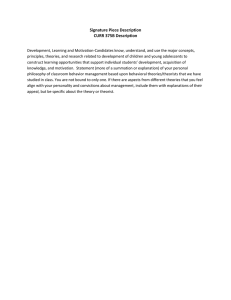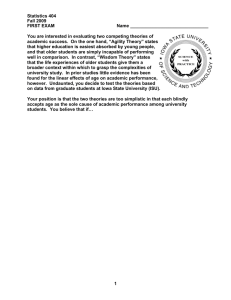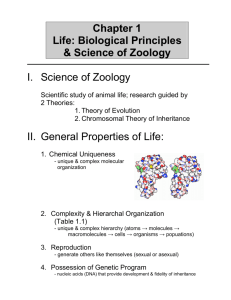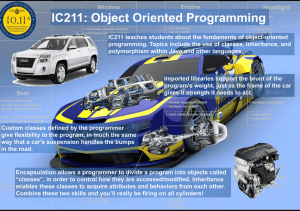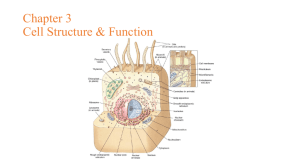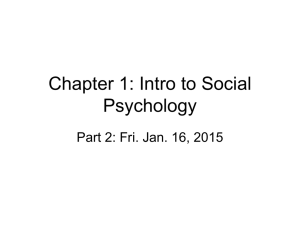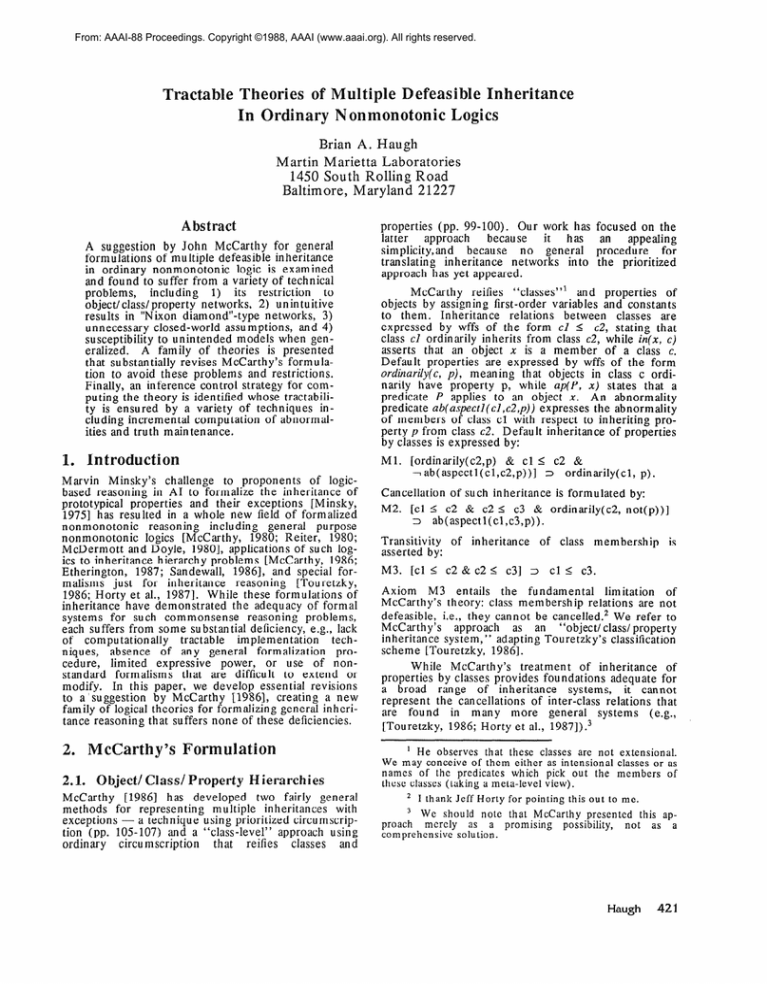
From: AAAI-88 Proceedings. Copyright ©1988, AAAI (www.aaai.org). All rights reserved.
Tractable
Theories of Multiple Defeasible Inheritance
onmonotonic Lo&s
In Ordinary
Brian A. Haugh
Martin Marietta Laboratories
1450 South Rolling Road
Baltimore,
Maryland 21227
Abstract
A suggestion by John McCarthy for general
formulations of multiple defeasible inheritance
in ordinary nonmonotonic
logic is examined
and found to suffer from a variety of technical
including
1) its restriction
to
problems,
object/class/property
networks, 2) unintuitive
results in “Nixon diamond”-type
networks, 3)
unnecessary closed-world assumptions,
and 4)
susceptibility to unintended
models when genA family of theories is presented
eralized.
that substantially revises McCarthy’s formulation to avoid these problems and restrictions.
Finally, an inference control strategy for computing the theory is identified whose tractability is ensured by a variety of techniques
including incremental computation
of abnormalities and truth maintenance.
1.
2.1.
McCarthy
reifies “classes”’
and properties
of
objects by assigning first-order variables and constants
to them. Inheritance
relations
between
classes are
expressed by wffs of the form cl I c2, stating that
class cl ordinarily inherits from class c2, while in(x, c)
asserts that an object x is a member of a class c.
Default properties are expressed by wffs of the form
ordinarily(c,
p), meaning
that objects in class c ordinarily have property p, while ap(P, x) states that a
predicate P applies to an object X. An abnormality
predicate ab(aspectl(cl,c2,p))
expresses the abnormality
of members of class cl with respect to inheriting property p from class c2. D efau It inheritance of properties
by classes is expressed by:
Ml.
Marvin Minsky’s challenge
to proponents
of logicbased reasoning in AI to formalize the inheritance of
prototypical properties and their exceptions
[Minsky,
19751 has resulted in a whole new field of formalized
nonmonotonic
reasoning
including
general
purpose
nonmonotonic
logics [McCarthy,
1980; Reiter, 1980;
McDermott and Doyle, 19801, applications of such logits to inheritance hierarchy problems [McCarthy, 1986;
Etherington,
1987; Sandewall, 19861, and special formalisms just for inheritance
reasoning
[Touretzky,
1986; Horty et al., 19871. While these formulations of
inheritance have demonstrated
the adequacy of formal
systems for such commonsense
reasoning problems,
each suffers from some substantial deficiency, e.g., lack
of computationally
tractable
implementation
techabsence of any general formalization
proniques,
cedure, limited expressive
power, or use of nonstandard formalisms
that are difficult to extend or
modify. In this paper, we develop essential revisions
to a ‘suggestion by McCarthy [1986], creating a new
family of logical theories for formalizing general inheritance reasoning that suffers none of these deficiencies.
2.
properties (pp. 99-100). Our work has focused on the
it
has
an
approach
because
latter
appealing
simplicity,and
because
no general
procedure
for
translating
inheritance
networks
into the prioritized
approach has yet appeared.
ccarthy’s
Formulation
bjectl Class/ Property
McCarthy
[1986] has developed
two fairly general
methods for representing
multiple inheritances
with
exceptions - a technique using prioritized circumscription (pp. 105107) and a “class-level”
approach using
that reilies
classes
and
circumscription
ordinary
[ordinarily(c2,p)
& cl I c2 &
l ab(aspectl(cl,c2,p))]
1 ordinarily(c1,
p).
Cancellation of such inheritance is formulated by:
M2. [cl I c2 & c2 I c3 & ordinarily(c2, not(p))]
1 ab(aspectl(cl,c3,p)).
Transitivity
of
asserted by:
M3.
inheritance
[cl 5 c2 & c2 5 c33 3
of
class
membership
is
cl < c3.
Axiom
M3 entails
the fundamental
limitation
of
McCarthy’s theory: class membership
relations are not
defeasible, i.e., they cannot be cancelled.
We refer to
McCarthy’s
approach
as an “object/ class/ property
inheritance system,” adapting Touretzky’s classification
scheme [Touretzky, 19861.
While McCarthy’s
treatment
of inheritance
of
properties by classes provides foundations adequate for
a broad range of inheritance
systems,
it cannot
represent the cancellations
of inter-class relations that
are found
in many more general
systems
(e.g.,
[Touretzky, 1986; Horty et al., 1987]).3
t He observes
that these classes
are not extensional.
We may conceive
of them either as intensional
classes or as
names
of the predicates
which
pick out the members
of
these classes (taking a meta-level
view).
2 I thank
Jeff Horty
for pointing
this out to me.
3
WC should
note that McCarthy
presented
this approach
merely
as a promising
possibility,
not
as a
comprehensive
solulion.
Haugh
421
2.2. Problems
2.2.1.
A Natural Extension
The most natural extension
of McCarthy’s formalism to handle exceptions
to class membership
inheritance
treats them in the same manner that he
treats exceptions to property inheritance,
by replacing
his axiom M3 as follows:
M3a.
[cl I c2 & c2 5 c3 & --, ab(aspectl(cl,c2,c3>)]
3 cl 5 c3
M3b.
[cl S c2 & c2 5 c3 & c2 5 not(c4)]
1 ab(aspectl(cl,c3,c4))
This leads to the intended results in simple class inheritance cancellation cases, such as that shown in Figure
1, although it will admit unintended
models in slightly
more complex networks if we simply minimize abnormalities (as McCarthy does).
Figure 1. Simple class cancellation
2.2.2.
Unintended Models With Gratuitous Links
In some inheritance
networks,
there will be
models of this extended theory which are minimal in
abnormalities
but achieve that condition by admitting
entirely new direct links that cancel the inheritance of
intended abnormalities.
For example, the network of
Figure 2 will have minimal models with a gratuitous
explicit link A I not(C), which creates the unintended
abnormality
ab(aspectl(A,
B, C)) while blocking the
in tended
inheritance
of the
dual
abnormalities
ab(aspectl(A, D, F)) and ab(aspectl(A, D, E)). Thus,
simply minimizing abnormalities
will block many of the
intended results (e.g., A 5 C) in such cases.
This problem
is characteristic
of the general
scheme
of directly
minimizing
abnormalities
in
abnormality-based
meta-level
general inheritance
systems and is independent
of our particular formulation
of the axioms. When abnormalities
can be inherited,
and that inheritance
can be cancelled, there will be
models of many networks that will have fewer abnormalities if an unexplained
cancellation
of inheritance
holds.
Thus, we conclude that simple abnormality
minimization
will not provide the intended results in
any such theories.
2.2.3.
Excessive Closed-World Assumptions
of simply
minimizing
McCarthy’s
approach
abnormalities
cannot escape a wide variety of closedworld assumptions
which violate common
sense in
the abnormalities
of indivimany cases. Minimizing
dual objects, for example, entails that no objects with
any abnormalities (e.g., penguins) exist unless they can
be proven to exist. This pervasive problem arises in
object-level
theories
of
inheritance
McCarthy’s
[McCarthy, 19861 as well as in his meta-level theories,
and in all other previous logic-based object-level formulations (e.g., [Lifschitz, 1985; Etherington,
19871).
2.2.4.
Unintuitive Results In “Nixon Diamonds”
McCarthy’s
theory
encounters
a variety
of
difficulties when applied to certain kinds of inheritance
networks which I call “Nixon diamonds,”
after the original example of this type developed by Reiter and
illustrated
by Figure 3. More general “Nixon diamonds” consist of pairs of arbitrary length, multi-link
paths between two nodes, where the final links are contrary also referred to as “conflicting
multi-link
paths.” McCarthy’s theory properly handles the original Nixon diamond,
in which “Nixon”
refers to an
individual, provided the implicit axiom ap(p,x) 3 7
ap(not(p),x) is assumed.
Difficulties arise, however, in
“generic Nixon diamonds,”
in which the root (Nixon)
is a class (e.g., Nixon’s family) instead of an individual, and in “extended
Nixon diamonds,”
where the
multi-link paths are longer than two links (as in Figure
4).
pacifist
republica
uaker
Io*zyI
in
nixon
*
Key
Figure 3. Original Nixon diamond
pacifist
Kev
Figure 4. Extended Nixon diamond
Figure 2. Unintended
422
Knowledge
Representation
models
In extended Nixon diamonds, McCarthy’s theory
entails that some abnormality
holds, blocking one of
the conflicting
paths (as expected),
but will be
indifferent between all the possible link cancellations.
Commonsense
reasoning, however, preferring the least
disruption to its default beliefs, tends to conclude that
only the last links in conflicting multi-link
paths are
suspect, allowing the intermediate conclusions to stand.
3. Excluding
Unintended
Models
3.1. Alternative Methods
From the problems with unintended
models that we
identified
for the natural
extension
of McCarthy’s
theory, it is apparent that common sense does not
prefer a simple minimization
of his abnormalities,
but
insists that no unexplained
abnormalities
should be
admitted in place of expected ones. Commonsense
use
of default relations assumes that there are no abnormalities interfering with prima facie default conclusions
unless they can be shown to follow from explicitly
known relations using basic rules of default cancellation. Once this general principle is recognized, its formulation proceeds quite naturally by definition of an
abnormality predicate ab in terms of the rules that genThen, minimizing
the explicit
erate abnormalities.
knowledge (direct links) required by those rules to
generate abnormalities
will restrict all such abnormaliThis solution comes at the prima
ties appropriately.
facie cost of a general closed-world
assumption
that
entails the falsehood of any general relations that are
not provable from such theories.
We will show, however, that such assumptions may be fully relaxed while
retaining
their benefits in excluding just the unintended abnormalities.
The other major alternative
for avoiding unintended models within this type of theory involves
minimizing
what I call “potential
abnormalities,”
i.e.,
those that would hold if there were no other anormalities blocking them. We do not present our theory for
minimizing
potential abnormalities
here because it is
more complex than minimizing direct links, and offers
no clear advantages for inheritance reasoning.
3.2.
Comparison to Temporal Reasoning
The two identified alternatives
for eliminating
unintended models of general inheritance
theories are
examples of general techniques of nonmonotonic
reasoning that have been applied previously in temporalcausal
reasoning
to exclude
unintended
models
identified for temporal persistence
theories [Hanks &
McDermott,
19861. Minimizing
types of causal relations was used by Lifschitz [Lifschitz, 19871 to eliminate models with unexplained
changes, just as minimizing types of explicit inheritance
relations here eliminates unexplained
inheritance cancellations,
Minimizing “potential
causes” was used by Haugh [Haugh,
19871 to eliminate spurious particular potential causes
of change (which would be actual causes if their
preconditions
held), just as minimizing potential abnormalities in inheritance
theories will exclude spurious
inheritance
cancellations.
Thus, our new results here
suggest a broad potential for application of these techniques to other nonmonotonic
reasoning issues.
p’s, where x can refer to either an individual
(or
object-level term) or a class (or object-level predicate),
and p refers only to either a class or property. General
network relations, both explicit and derived, can be
represented by isa(x,p).
A sorted logic is used in which upper case A, B,
C, D, Al, Bl, . . . are variables referring to individual
objects, while upper case M, N, 0, P, Q, R, S, T, Ml,
Nl
are variables for classes/ predicates, and upper
cask ietters from the end of the alphabet - u, v, w,
x, Y, z, Ul, Vl, . . . . are variables ranging over objects
and classes. Corresponding
lower case terms are used
for constants in the same categories, along with other
mnemonic
lower case constant names (e.g., elephant)
whose category should be obvious in context.
To reason about exceptions to default links, we
use an abnormality predicate modeled after McCarthy’s
use of a similar predicate, although our syntax is somewhat simplified. Where McCarthy uses a predication of
[McCarthy,
19861 to
the form ab(aspectl(X,P,Q))
represent
abnormalities,
we use ab(X,P,Q)
to mean
that object/class X is abnormal with respect to inheriting any existing default relation between P and Q. For
example, ab(royal-elephant, elephant, gray) asserts that
royal-elephants
are abnormal with respect to inheriting
any isa relation between elephant and gray, or, less formally, royal-elephants
are abnormal
elephants
with
respect to being gray. While McCarthy uses different
aspects (aspect1 and aspect2) to distinguish
between
particular and generic abnormalities,
we allow these
distinctions
to be determined
by the sorts of terms
appearing in ab predications.
4.2.
Core Inheritance
Axioms
4.2.1.
Network Relations
Using the notation just presented, and axioms for
generating
derived relations
from explicitly asserted
ones, we can formulate a broad range of inheritance
theories.
We identify a general family of theories
which share three core axioms and a simple minimization technique.
The first axiom defines all of the
default relations derivable from a network as:
Al.
isa(X,Q)
=
[isa-x(X,Q)
(!b3 &G-V)
4.1.
Inheritance
General Notation
To enable minimization
of explicit relations in our
closed-world theories, we distinguish them from other,
derived, relations by representing
them with distinctive
predicates. Explicit default network relations (or links)
are of the form isa-x(x,p), stating that x’s are normally
& 1 WXP,Q)ll
which states that X’s are (normally) Q’s if and only if
either there is an explicit network link asserting this, or
there is an intermediate
node P in the network such
that X’s are (normally)
P’s, there is an explicit link
asserting P’s to be Q’s (normally),
and X’s are not
abnormal with respect to P’s being Q’s. The abnormalities referred to are restricted to four primitive types:
A2. ab(X,P,Q)
=
[ab-d(X,P,Q)
ab-G,RQ)
4. Closed-World
v
& isa-x(RQ)
v ab-i(X,P,Q)
v
v ab-x(X,RQ)l.
Explicit abnormalities
(ab-x) are a type of cancellation
link that are explicitly asserted, while the other abnormalities are derived from conflicting isa x relations.
4.2.2.
Direct Abnormalities
Direct abnormalities
are created by the direct
override by a single explicit link of a prima facie
multi-link path in a network. The example network of
Figure 1 illustrates the direct abnormality
created by
Haugh
423
the cancellation of the path from penguin through bird
to pyer by the direct contrary link from penguin to
not(j7yer) .4
Our third core axiom characterizes
conditions under which direct abnormalities
A3.
ab d(X,P,Q)
-[isa( X,P)
=
& isa-x( P,Q)
the general
arise as:
& isa-x( X,not( Q))].
4.2.3.
Inherited Abnormalities
Our other types of abnormalities
admit of a broad
range of alternative interpretations,
none of which has
achieved any consensus as yet. Here, we present the
simplest version of inherited abnormalities.
It allows
“off-path
preemptions”
calls
what
Toure tzky
[Touretzky et al., 19871, in accord with the theories in
[Sandewall, 19861 and [Horty et al., 19871, and is formulated as:
A4.
ab-i(X,Q,R)
[abeW,Q,R)
=
(gP)[isa(X,P)
v ab-W,Q,W
&
v ab-x(RQ,R)ll.
Such inherited abnormalities exist for every descendant
X of a node P that has some direct or conflicting abnormality (e.g., ab-d(P,Q,R )). An example is illustrated
by Figure 1, wherein opus inherits an abnormality with
respect to birds being flyers from penguin.
Under this conception of inherited abnormality,
an abnormality requires only a path (isa(X,P)) from the
inheriting node (X) to the original abnormality
node
One plausible variation of this
(P) to be inherited.
would require every inherited abnormality ab-i(X,Q,R)
to have a path (path(X,P,Q))
all the way from the
inheriting
node X, through the original abnormality
node P, to the base node Q of the conflict link. This
stricter conception could be expressed by only a minor
variation of our axiom A4:
A4’. ab-i(X,Q,R)
= (&)[path(X,P,Q)
&
(aQ(P,Q,R)
v ab-c(RQ,W
v ab-W,Q,W
where
A4”. path(X,P,Q)
= [isa(X,P)
&
[[isa-x(P,Q) & 1 aW,P,Q)l
v
(~RHpatW,P,W
4.2.4.
Conflicting Path Abnormalities
A variety of incompatible
alternatives
for handling conflicting multi-link paths {or Nixon diamonds)
have been proposed in the literature, e.g., [Touretzky
et al., 1987; Horty et al., 19871. Approaches have
4 Note that all the directed
arcs of our illustrations
correspond
to isa-?- links in our theories,
while
a slash
through
arcs represents
relations
to the complement
class of
not(jiyer))
is
node,
as
isa x(penguin,
the
destination
line links correspond
to
represented
in Figure
1. Narrow
isa x links from individual
objects,
as isa-x(opus, penguin) is
represented
in Figure 1.
Knowledge
4.2.4.1. Skeptical Theories
in [Horty
Skeptical approach es, as distinguished
et al -, 19871, possess the considerable
computational
advantage of having unique extensions, which obviates
any need to examine -alternative
extensions
during
derivations.
Skeptical
theories
can be formalized
within abnormality
theories such as ours by asserting
the root of a general diamond to be abnormal with
respect to both of the final links to its top, i.e.,
Ambiguity-Blocking
Abnormality:
A5 ab-c(X,P,Q)
5
(sR)[isa( X,P) & isa-x(P,Q)
&
isa(X,R)
& isa-x(R,not(Q))
&
1 ab-dix( X,P,Q) & 1 ab-dix(X,R,not(Q))]
where
86. ab dix(X,P,Q)
=
bb~d(X,RQ) v ab-x(X,RQ) v
<!$>[isa(XS)
& bb-d(W,Q)
v ab_x(W,Q)lLs
This first set of conflicting-path
abnormality
axioms accords with Horty’s interesting
results for
“nested Nixon diamonds,”
as illustrated by Figure 5.
In this example, these theories block any conclusions
about the relations between X and R in the nested diamond, thereby blocking any positive path from X to Q
in the larger diamond, leaving the path from X through
P to not(Q) unopposed.
& isa-x(R,Q) & 1 aWW,QHll.
This variation appears to correspond to the treatment
in [Horty et al., 19871 when combined with ambiguityblocking skepticism in conflicting paths as described
Our intuitions
in discriminating
examples
below.
examined
thus far favor our initial formulation,
although further investigations
are indicated before this
issue can be considered settled.
424
been categorized as either “skentical”
or “credulous”
with regarYd to their willingness *to draw conclusions in
these &es.
Credulous th;ories insist that one of the
two conflicting terminal links must apply to the root
node in such cases (e.g., isa(nixon, pacifist), isa(nixon,
not(pac@st))
for Figures 3 and 4), while skeptical
theories
support
no such conclusions
(i.e.,
the
conflictin g links cannot be used to make any conclusions about the base node).
Representation
Figure 5. Nested diamonds
The “ambiguity-blocking”
skepticism just formulated may be considered unin tu itive becau se the positive path through a nested diamond (e.g., X --> F -->
R -->
Q in Figure 5) seems to remain a possible
conflicting path to its contrary alternative in the larger
diamond (e.g., X --> P -/-> Q in Figure S), as discussed in [Touretzky et al., 19871. Thus, it may seem
that
a reasonable
skentic
should
not
conclude
isa(X,not(Q)) in our example, and should propagate the
uncertaintv
of the nested diamond to the larger diamond.
Previous
attemnts
to
formulatesuch
“ambiguity-propagating”
ikepticism
have not been
successful, although it is quite straightforward
within
’ Note that our
tance
would
require
isa(X,S) in this axiom.
stricter
notion
a path(X,S,P)
of abnormality
instead
of the
inherisimple
our abnormality
theories,
using the following
Ambiguity-Propagating
Abnormality:
A5’. ab-c(X,P,Q)
=
(SR) [isag(X,P)
& isa-x(P,Q)
&
isag( X,R) & isa-x( R,not( Q) ) &
7 ab-dix( X,P,Q) & I ab-dix(X,R,not(Q))]
where
A7. isag(X,R)
E [isa-x(X,R)
v
(gT)[isag(X,T)
& isa-x(T,R)
& I ab-dix(X,T,R)]].
These axioms function by defining potential isa relations between nodes (e.g., isag(X,R)
in Figure 5) that
will be genuine relations if theyH;;c;ot
cancelled *by a
these axroms
conflicting
multi-link
path.
enable cancellation
of all paths from’ roots to tips in
embedded Nixon diamonds, and yield complete skepticism about all such relations (e.g., between X and R
and between X and Q in Figure 5).
4.2.4.2.
Credulous
Theories
Less skeptical theories are possible if we require
only that one or the other of two conflicting paths is
blocked, as formalized in [Haugh, 19881.
erforming
4.3.
the
2)
abnormality ab(a,q,r) as itself.
Translate every isa-x(a,p), where a is an indiviz;y;;astant,
as p(a), and every isa-x(a. not(p))
3)
Translate
every explicit default
as ttp(W
&
axioms:
inimizations
Minimization
of explicit relations can be conveniently
performed
by parallel circumscription
of our explicit
link predicates isu x and ab-x. Alternatively,
for nondisjunctive
theories, we may define a single explicit
link predicate in terms of them and circumscribe
it,
e.g.:
link(X,P,Q)
E [ab-x(X,P,Q)
v
(isa-x( X,P) & Q = isa# )]
where isa# is a reserved constant that simply restricts
the range of the extra variable. We can achieve the
same effect as circumscription
of link in a default logic
[Reiter, 19801 with the single normal default rule:
: link( al,c2,c3)
-, link(al,c2,c3)
I
which asserts that whenever
it is consistent
for no
explicit link to exist between nodes, we may infer that
there is none.
4.4. Fulli Object-Level Interpretations
It is possible to translate all of our meta-level default
relations into object-level axioms using ordinary predicates. These translations, however, cannot occur in isolation, since all the relevant abnormalities
can be determined only from the structure of the network as a
whole. Thus, if we wish an object-level translation, we
must determine the relevant abnormalities
based upon
the structure of the whole net, using our meta-level
axioms above, and combine these derived abnormalities with the individual translations of each link.
After all the provable abnormalities
are determined from a meta-level
theory, translation
should
proceed as follows:
1) Translate each general abnormality abtp,q,r) as
particular
ab(X,q,r)]
and
each
MW
=
.
4)
5)
5.1.
- aW,p,q)l
3
relation
isa-x(p,q)
4(X)1.
Translate every explicit abnormality
ab-x(X,p,q)
as ab(X,p,q).
Minimize
specific abnormalities
(ab(X,P,Q))
in
the new theory.
Illal
redicate Glasses
5.1.1.
MetsLevel
Theories
Our closed-world
theories yield just the right
results
regarding
abnormalities,
but make
more
assumptions
than necessary about what isn’t provable.
Ideally, we would like to keep the abnormality results,
yet no longer insist that all the excluded primitive links
are false. This can be accomplished
by dividing our
predicates into two parallel classes, one in which the
closed-world
minimizations
are
performed,
and
another, general all-inclusive
class, in which there are
no explicit minimizations,
but only some restrictions to
prevent interference
with the results of the closedworld minimizations.
In particular,
let us create new predicates by
predicate
appending
a “*” to all of our previous
names, e.g., isa x* instead of isa-x, and ab x* instead
of ab-x. Then, we may rewrite our axiom< using the
new predicates, creating a new theory H* whose general axioms correspond to to the old theory H. All of
the links of particular
inheritance
theories will be
expressed in H*, and will be minimized as above. But,
now our minimized
H* theory is only a subset of a
larger theory H** which includes H and H*, wherein
the predicates of H* are considered
as instances of
those of H, formalized:
isa*(X,P) 2 isa( X,P)
ab*(X,P,Q)
z, ab(X,P,Q),
etc.
Thus, the minimizations
of H* will no longer
entail closed world assumptions
with respect to H**,
since explicit links that are absent from H* may still
appear in H. Finally, H** will need one more axiom to
exclude any new relations in H that could otherwise
cancel conclusions of the closed-world theory H*.
[isa*(X, Q) & I isa-x*(X, not(Q))]
2
isa(X, not(Q)).
I
This asserts that no unopposed network relation of the
original closed-world theory H* is ever opposed by a
contrary relation in the larger theory.
This excludes
unwanted
models while allowing any other relations
that don’t conflict with the original theory. We might
also wish to restore the law of the excluded middle to
our meta-level
theory for properties
of individual
objects, i.e.,
isa(A,P)
1 l isa(A,not(P)).
With this formalization
of open-world
inheritance, we may selectively specify any degree of closure
Haugh
425
assumptions
we like for particular
predicates.
5.1.2.
Object-Level Interpretations
Object-level predicates would also come in pairs,
and network relations would be translated into starred
predicates (e.g., isa-x*(p,q) translates into [[p*(x) & l
ab*(x,p,q)]
=I q*(x)]).
The additional axioms relating
starred and unstarred predicates would also be required
Cl(x)])
for all object-level predi(e.g., [C;r “(x) 3
object-level
open-world
After
translation,
cates.
theories would proceed to minimize the provable direct
thereby
permitting
any other
abnormalities
(ab*),
abnormalities
that did not disagree with the positive
conclusions
of the closed-world
theories.
Additional
closed-world assumptions may also be added for particular classes, as desired, providing the fullest flexibility
in specifying the intended assumptions.
5.2.
Auto-Epidemic
Interpretations
Our use of dual predicates in open-world
theories is
highly suggestive of an interpretation
in auto-epistemic
theories. Our starred explicit relations are quite clearly
just those that can be proven to hold, i.e., those that
are “known” by the system. Thus, it would be natural
to translate the entire theory into an au to-epistemic
logic in which the starred relations are translated into
statements
of knowledge,
according to the following
type of schema:
isa-x*( X,P) = > Knows isa-x(X,P)
ab-x*( X,P) = > Knows ab-x(X,P)
Object-level
translations
would be analogous,
and
semantically revealing:
isa-x*(P,Q)
= >
Knows ab( x,P,Q)]
[[Knows P(x) &
3 Knows Q(x)]
Thus, a default relation between P and Q can be interpreted as asserting that if something is known to be P
and is not known to be abnormal with respect to being
Q, then it is known to be Q.
Although more work is required on the formal
details of such auto-epistemic
versions of our theories,
they offer considerable
promise in providing deeper
semantic foundations
and more coherent integration
with general theories of an agent’s knowledge
and
self-reflection.
I
6. Computing
the Theory
Our formulations
are very simple
nonmonotonic
theories (using a single normal default, or a single simple circumscription),
which allow use of the simplest
nonmonotonic
technique
of negation
by failure to
minimize
explicit inheritance
links, or to minimize
abnormalities in the object-level theories. Furthermore,
the skeptical versions of our theories have models that
are provably unique with respect to abnormalities,
so
that alternative extensions needn’t be examined.
Our
theories have also been formulated to avoid generating
abnormalities
found
in
unnecessary
the
Thus, the difficulties of
McCar?l$i
original proposal.
computing
the consequences
of general inheritance
theories have already been minimized significantly by
the form of our theories.
Computational
demands are
further reduced in our implementation
scheme by
426
Knowledge
Representation
careful incremental
derivation of abnormalities,
truth
maintenance
on them,
and inference
algorithms
tailored to query types. This scheme and its implementation in Prolog is described in depth in a longer
report [Haugh, 19881.
A key technique in computing the consequences
of our theories is an initial determination
of abnormalities which avoids their repeated computation
on every
query. Truth maintenance
is performed on all derived
abnormalities,
since subsequent
changes may undermine the justifications for current abnormalities.
With
all the current abnormalities
kept updated, queries are
processed very efficiently by tracing the unblocked
paths through a network.
Acknowledgements
I am especially indebted to Jeff Horty for assistance in
identifying
the limitations
of previous work. I also
thank Steve Barash, Steve Jameson, Stuart Pearlman,
and Donald Perlis for helpful comments.
References
Etherington,
D.W.
1987. “Formalizing
Nonmonotonic Reasoning
Systems,”
Artificial Intelligence,
31( 1):41-86.
Hanks, S. and D. McDermott.
1986. “Default Reasoning, Nonmonotonic
Logics, and the Frame Problem,” in AAAI-86, pp. 328-333.
Haugh, B. 1987. “Simple Causal Minimizations
for
Temporal Persistence and Projection,”
in AAAI-87,
pp. 218-223.
Haugh, B. 1988. “Tractable Logical Theories of Multiple Defeasible
Inheritance,”
Martin
Marietta
Laboratories Technical Report (forthcoming).
Horty, J., R. Thomason, and D. Touretzky.
1987. “A
Skeptical Theory of Nonmonotonic
Semantic Networks,” in AAAI-87, pp. 358-363.
Lifschitz, V. 1985. “Computing
Circumscription,”
in
IJCAI-85, pp. 121-127.
Lifschitz, V. 1987. “Formal Theories of Action (Preliminary Report),” in IJCAI-87, pp. 966-972.
McCarthy, J. 1980. “Circumscription
- A Form of
y;;;M3yotonic
Reasoning,”
Arr@cial Intelligence,
..
-
.
McCarthy, J. 1986. “Applications
of Circumscription
Formalizing
Common-Sense
Knowledge, ”
?r@iciul Intelligence, 28( 1) :89- 116.
McDermott, D. and J. Doyle. 1980. “Non-Monotonic
Logic I,” Artificial Intelligence, 13:41-72.
Minsky, M. 1975. “A Framework
for Representing
Knowledge, ” In Psychology of Computer Vision, P.
Winston (ed.), New York: McGraw-Hill,
pp. 211277.
Reiter, R. 1980. “A Logic for Default Reasoning,”
Artifccial Intelligence 13181-132.
Sandewall, E. 1986. “Nonmonotonic
Inference Rules
for Multiple
Inheritance
with Exceptions,”
in
Proceedings of the IEEE, 74( 10):1345-1353.
Touretzky, D. S. 1986. The Mathematics of Inheritance
Systems, Los Altos: Morgan Kaufmann.
Touretzky, D., J. Horty, and R. Thomason.
1987. “A
Clash of Intuitions: The Current State of Nonmonotonic Inheritance
Systems,”
in IJCAI-87, pp. 476482.

